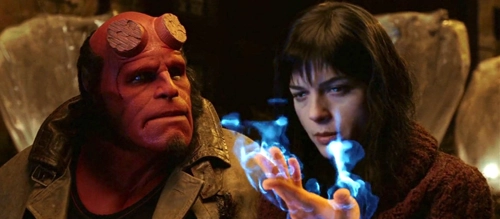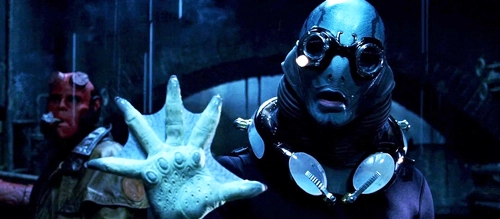‘Hellboy’ at 20 – Review

Hellboy (2004)
Director: Guillermo del Toro
Screenwriter: Guillermo del Toro
Starring: Ron Perlman, Selma Blair, Doug Jones, John Hurt, Rupert Evans, Karel Roden, Jeffrey Tambor, Brian Steele, Ladislav Beran, Biddy Hodson, Corey Johnson, Kevin Trainor
In 2004, over a decade out from his Oscar win for The Shape of Water, Guillermo del Toro had directed two Spanish-language passion projects with Cronos and The Devil’s Backbone and two less personal films in Hollywood with Mimic and Blade II. Next, he chose to adapt one of his favourite comic book characters, one more obscure to the average audience: Mike Mignola’s Hellboy. But how much of Mignola’s Gothic, Lovecraftian and folklore-influenced superhero procedural would make it to the big screen? If there was one man up to the task it was Guillermo del Toro.
After helping a squad of American soldiers to thwart a Nazi plot to gain supernatural powers in the final months of World War II, paranormal expert Professor Trevor Bruttenholm (John Hurt) adopts a demon child who came through the resulting portal to Hell. 60 years later, the now fully grown Hellboy (Ron Perlman) is sent on missions by secret government organisation the B.P.R.D (Bureau for Paranormal Research and Defence) and must stop a resurrected Grigori Rasputin (Karel Roden) from bringing forth eldritch gods to destroy the world.
“There are things that go bump in the night… and we are the ones who bump back!”
If you absolutely have to deliver thematically relevant exposition, John Hurt was always top of the list to deliver it. Playing a character at least 20 years older than he actually was at the time, Hurt is a wise and welcoming guide to bring us into del Toro’s take on Mignola’s universe. FBI Agent John Myers (Rupert Evans) is our predictably bland audience P.O.V character brand new to this strange and unusual world, subsequently and unceremoniously written out of the sequel. Character actor extraordinaire and del Toro good luck talisman Ron Perlman impresses in one of his rare leading roles as a gruff but loveable lunk, and the villains are a colourful mix of pulp horror archetypes.
Hellboy has simply gorgeous cinematography from Guillermo Navarro (Pan’s Labyrinth), especially in the stormy opening ritual sequence combined with slick action scenes and an unparalleled focus on meticulously detailed and tactile production design. All of these elements make such an impact because sadly comic book movies never look this good today.
Del Toro’s unconditional love of all things monstrous really comes across. From Big Red himself to fish-man Abe Sapien (Doug Jones) and pyrokinetic introvert Liz Sherman (Selma Blair), even corrupted biblical hellhound Sammael (Brian Steele); he has affection for them all and clearly relishes bringing them to life. About the only monster he seemingly doesn’t love – though he still looks really cool – is the self-mutilating, blade-twirling, gas-masked assassin Kroenen, and that’s just because he’s a psychotic Nazi zombie.

For all his predisposition for the macabre, with particularly childish glee reserved for anything slimy, dead or insectoid, del Toro is still a big old romantic at heart. “What’s a good solid word for ‘need’? / Need’s a good word / Too needy.” There’s a standout moment where Hellboy, who is a lot younger than he looks, is given relationship advice by a nine year-old on a rooftop. As Mignola himself wryly noted, “Somehow del Toro’s Hellboy is still a lovesick teenager […] My Hellboy, there were no girl problems”. World-ending consequences don’t change the fact that a lot of this comes down to an awkward red ape not being able to effectively communicate with his adopted dad or tell his fire-starting goth girlfriend how he really feels.
A memorable character theme is a must for any new superhero franchise and Hellboy is provided a particularly moody one by Marco Beltrami that by all rights might have become as well known as those composed by Danny Elfman and Hans Zimmer had this film done just a little better, the former taking on the role of composer for Hellboy II: The Golden Army four years later.
This does the classic first movie in a new franchise origin story and features a steadily more difficult series of boss fights, but leans more into horror and suspense conventions for its more memorable set pieces, like when Abe goes underwater to hunt for Sammael’s lair and becomes the hunted, or when Kroenen revives himself on the morgue table.
The majority of the action and creature effects are achieved practically here, with CG enhancements only used in conjunction with the good old-fashioned techniques of animatronics and wirework. Sticking to this methodology is admirable even if this occasionally results in a slightly jarring effect two decades on when one technique necessarily gives way to another. The studio setup and budget/tax cut-necessitated nighttime location shooting in Eastern Europe (the production, like Blade II, was based in Prague) breaks the illusion slightly by not looking enough like New York.
If we’re being honest, Hellboy is probably only mid-tier del Toro, but that still makes it better than the majority of comic book adaptations out there. It was only a modest success at the time and might have been a little too weird for the average superhero movie fan, but it did spawn a more confident sequel and give del Toro a springboard to more freedom as Hollywood’s favourite genre filmmaker. It was at this point that he appears to have gained the ability to switch between modes and levels of filmmaking at will – commercial studio projects or more arthouse pieces – to suit the given audience. It is a pity that he never got to cap off his Hellboy trilogy, but two movies’ worth of Guillermo del Toro’s version of Mike Mignola’s world, one fan of monsters and mythology adapting another, is still a treat to behold.
Score: 18/24

